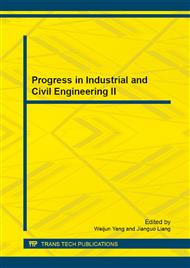p.483
p.491
p.495
p.499
p.507
p.511
p.521
p.527
p.535
Modeling Design and Finite Element Analysis of the Hydraulic Gradual Transition
Abstract:
The inlet and outlet of the aqueduct and the inverted siphon, standing a gradual transition linked to the channel, make water gradually change along the cross section of the gradual transition, to improve the water flow pattern. This paper aims to research the deformation of the gradual transition under the water load in static water conditions, to make ANSYS finite element analysis to the engineering gradual transition for preventing deformation, and finally to optimize the overall style design on the basis of its analysis. The developed techniques have been successfully used in designing the gradual transition of a practical aqueduct project. The results of this study on the gradual transition have strong theoretical and practical significance.
Info:
Periodical:
Pages:
507-510
Citation:
Online since:
September 2013
Authors:
Keywords:
Price:
Сopyright:
© 2013 Trans Tech Publications Ltd. All Rights Reserved
Share:
Citation:


